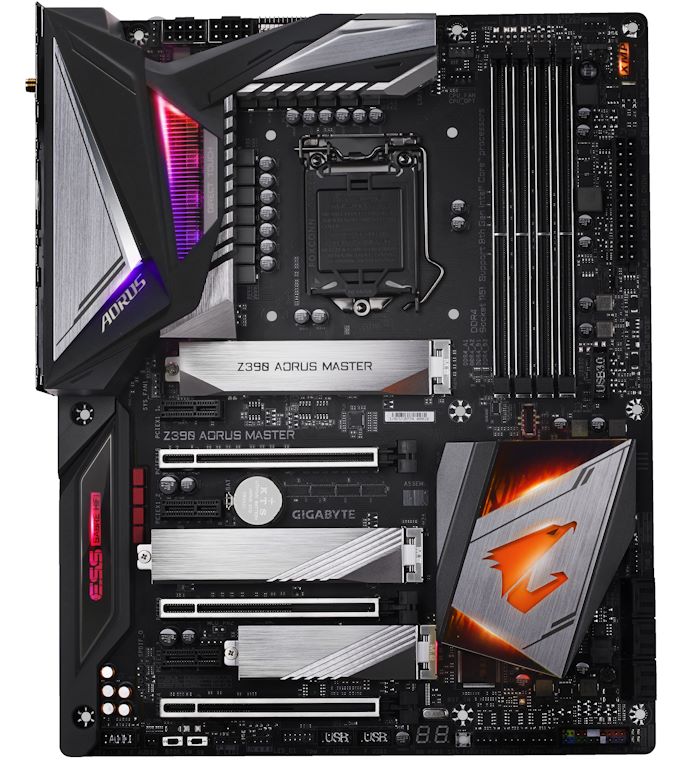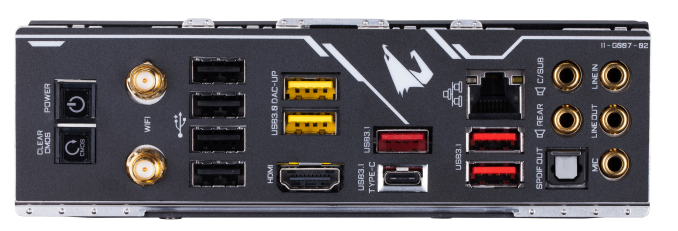Intel Z390 Motherboard Overview: 50+ Motherboards Analyzed
by Ian Cutress & Gavin Bonshor on October 8, 2018 10:53 AM EST- Posted in
- Motherboards
- Intel
- MSI
- Gigabyte
- ASRock
- EVGA
- Asus
- NZXT
- Supermicro
- Z390
GIGABYTE Z390 Aorus Master
Just like we noted in our AMD B450 launch motherboards overview, GIGABYTE has gone through a transitional period of late when it comes to branding. To make their naming scheme a little easier to decipher, the move isn't just for the benefit of users looking to distinguish between different types of motherboard, but it also allows GIGABYTE to tie in different components such as graphics cards and align them together from a marketing perspective. The new naming scheme essentially narrates the class of motherboard so for example, the AORUS Gaming 9 which was GIGABYTE's Z270 flagship is now known as the AORUS Xtreme. Other examples of GIGABYTE moving away from a numbering naming scheme include the AORUS Z390 Master which replaces the AORUS Z370 Gaming 7 and the Z390 Aorus Elite which is the successor of the Aorus Z370 Gaming 3. For the Z390 chipset launch GIGABYTE has announced a total of 11 new motherboards.
GIGABYTE Z390 Aorus Master
Starting off with one of the most unique offerings from GIGABYTE is the Z390 Aorus Master which is the only board from GIGABYTE's line up to feature a backplate. On top of this, the Z390 Aorus Master features triple PCIe 3.0 x4 M.2 slots which are all complemented with a set of M.2 heatsinks. The board is also equipped with a total of six SATA ports which has support for RAID 0,1,5 and 10 arrays. The GIGABYTE Z390 Aorus Master has support for up to DDR4-4133 with a maximum capacity of up to 64 GB across the four available RAM slots.
The GIGABYTE Z390 Aorus Master is a full-sized ATX motherboard and is advertised to have one of the most comprehensive power deliveries of their Z390 line-up with a 14-phase setup; probably in a 12+2 configuration. PCIe wise the board has a trio of PCIe 3.0 full-length slots with the top slot operating at x16, the second slot x8 and the third slot at x4; all three full-length slots feature metal slot reinforcement. The board does have support for two and three-way CrossFire and SLI multi-graphics configurations. In addition to this is three PCIe 3.0 x1 slots which sit above each full-length slot. Along the bottom side of the motherboard is an LED debug and the Master benefits from dual BIOS with the selector switches located along the bottom full-length PCIe slot.
Design wise the Z390 Aorus Master looks rather familiar and resembles the Z370 Gaming 7 which this model seemingly replaces and slots in between the new Z390 Aorus Xtreme and the Z390 Aorus Ultra models which puts the Master as one of GIGABYTE's top models. The Master has a full rear IO cover which extends across the VCore power delivery heat sink and also benefits from a pre-installed rear IO shield. Style wise the board offers multi-zone integrated RGB LEDs into the rear panel cover, the chipset heatsink and across the cover which sits across over audio PCB section.
The rear panel consists of three USB 3.1 Gen2 Type-A ports, a single USB 3.1 Gen2 Type-C port and four USB 2.0 ports; the board does have two USB 3.0 Type-A ports too which give support for GIGABYTE's DAC-UP audio technology. The five 3.5mm audio jacks and the S/PDIF optical output are controlled by a Realtek ALC1220-VB HD audio codec which includes an ESS Sabre 9118 DAC and the single LAN port takes its direction from an Intel I219V Gigabit controller. A single HDMI video output is present along with a Clear CMOS and rear panel power switch which sits next to two antennae tugs which support 2T2R Wave 2 compatible 802.11 Wi-Fi connections.
It's clear that the Z390 Aorus Master is targeted towards the enthusiast looking to make use of one of higher end 9th generation Intel processors such as the new eight-core processors which include the Core i9-9700K and Core i9-9900K which are due to launch a couple of weeks after the initial Z390 motherboard launch. The board has some overclocking credence to it with its advertised 14-phase power delivery and users looking to utilize the integrated Wave 2 capable 802.11ac and Bluetooth 5 connectivity, the Z390 Aorus Master is one for the shortlist. GIGABYTE has set an MSRP of $290 at launch which makes the Z390 Aorus Master the most expensive option in its current Z390 stack.












79 Comments
View All Comments
gavbon - Tuesday, October 9, 2018 - link
Thank you Hickory, will update now; this information wasn't available to us at the timebill44 - Tuesday, October 9, 2018 - link
All this boards, but only 1 with Thunderbolt 3. Looks like Thunderbolt 3 is dead (free or not).Type C ports and HDMI 2.0 is in short supply too.
Hopefully next year, we can have two or more USB C (maybe even 3.2), HDMI 2.1, PCIe 4/5 and Thunderbolt 3/4 (Titan Ridge?). Or maybe not, just the same old things hoping for 2020/21.
DanNeely - Tuesday, October 9, 2018 - link
There's no licensing fee for TB, the controller chip itself still costs money (IIRC $20 or $30) and still eats 4 PCIe lanes. Worse, IIRC to make the video out feature work they need to be CPU lanes; meaning that adding it means your main GPU slot is an x8, and the secondary one only x4.gavbon - Tuesday, October 9, 2018 - link
Yeah it's a case of certain vendors opting to dismiss including TB3 ports, which only seems sensible on mini-ITX boards where PCIe lanes aren't too much of an issue. Consumer choice is important though and I'm still glad ASRock has included it; it could be a key buying decision for some!gamingkingx - Friday, October 12, 2018 - link
Just too bad it is only wired as a x2.. And it is wired into the chipset as far as I am aware, so you are gonna max out your I/Os pretty fast.bill44 - Wednesday, October 10, 2018 - link
Sure, anything you add will cost something. The are plenty of non-gamers who prefer TB3 vs x16.This also highlights how old current PC architecture is. Either we need more PCIe lanes, or faster lanes. Otherwise, all advances will be hindered.
Up to 6 USB 3.1 Gen 2 ports? You’ be lucky to get 4. Why can’t we have 6 Gen2 ports and the rest Gen1 an no antiquated USB 2.0? PCIe resources.
All new peripherals use Type C, but this boards generally give you only 1 (saving money on redrivers). USB 3.2 (20 Gbps)? When it comes around, ithis too will need more PCIe lanes. M.2. PCIe 3.0 x4? All lanes are maxed out; the only way forward is faster lanes.
In the past, Gigabyte was a TB3 champion including the functionality on many of their boards. Now, not a single one.
Cost saving by motherboard makers? Prioritising gamers? Or simply no demand for TB3.
The outcome is the same.
repoman27 - Thursday, October 18, 2018 - link
Intel merely said that they planned "to make the Thunderbolt protocol specification available to the industry under a nonexclusive, royalty-free license" sometime this year. This hasn't happened yet, and is referring to the protocol spec, not the silicon that Intel produces. If and when they decide to do this, ASMedia or whoever could then begin development of their own Thunderbolt controllers. This means that third-party controllers probably won't appear in shipping products until sometime in 2023.As for the currently available Thunderbolt 3 controllers, tray prices range from $6.45 to $9.10. But you also need a USB Type-C and PD controller, power switch, and high-speed mux which runs around $4.59, plus the connector and a few other bits. I don't believe Intel charges a royalty on finished Thunderbolt products, but they do require licensing and certification which are paid for by the OEM and may add significant cost to relatively low-volume products.
AFAIK, Windows PCs are still required to connect Thunderbolt controllers via the PCH. Apple is the only one using PEG lanes for Thunderbolt, and they don't do that on the 27-inch iMacs where it might adversely impact the GPU.
Dug - Tuesday, October 9, 2018 - link
I hope it's not dead. Far more useful than USB C. I would be fine with USB C except there doesn't seem to be a good USB C to USB C hub, which really restricts how many devices you can use. I'm really glad to see it on ASRock itx board so I can attach a portable SSD array.imaheadcase - Wednesday, October 10, 2018 - link
Tons of monitors of USB-C, anker sells USB-C hubs, I don't think i've seen thunderbolt in a desktop PC to date though. That best part of USB-C is being able to just plug phone into it and copy paste to desktop files (no Microsoft didn't invent that, it was always that way by default in windows)Valantar - Wednesday, October 10, 2018 - link
TB3 is far from dead, it just has little use in desktop PCs. Have you looked at laptop lineups recently? TB3 is _everywhere_. My workplace (a major university here in Norway) has moved entirely to TB3 docking solutions as they're the only full-featured and universal(-ish) solution.eGPUs are useless on desktops. Desktops don't need docks. USB 3.1 is plenty fast for external storage, and if you need faster storage, desktops can fit that internally. The only real use cases for TB3 on a desktop are TB3 networking (for fast direct transfers between PCs) and adding things like extra NVMe or >GbE networking on ITX boards that don't have room for that and a GPU.